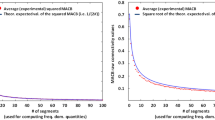Abstract
Objective.Several studies suggest that parameters derivedfrom bispectral analysis of the EEG can be used to characterize specificcortical activation states represented by non linear interaction betweenbrain electrical oscillations. For example, it was shown that so-calledbispectral indices can be used to assess the depth of sedation. Themethods applied so far are based on interval-related procedures ofbispectral analysis. Consequently, the use of the resulting parametersfor on-line monitoring or investigations of signal properties duringtransition periods, e.g., when entering burst-suppression periods, isrestricted. The objective of this paper is to provide the methodologicalbasis for a time-continuous (on-line) investigation of quadratic phasecoupling induced by amplitude modulation. Methods.To accomplishthis aim an algorithm is presented which enables the analysis of thetemporal development in the degree of amplitude modulation (DAM), e.g.,during the transition to burst-suppression periods in patients withsevere neurological diseases. Results.It was found that theseperiods are associated with increasing DAM compared with the baselineconditions.
Similar content being viewed by others
REFERENCES
Alexopoulos V, Kollias S, Leger P, Boccalon H, Csiki Z. Higher-order spectral analysis in laser-Doppler flow-metry signal analysis. Technology and Health Care 1999; 7: 85–101
Arnold M, Doering A, Witte H, Dörschel J, Eiselt M. Use of adaptive Hilbert Transformation for EEG segmentation and calculation of instantaneous respiration rate in neonates. J Clin Monit Comput 1996; 12 (1): 43–60
Arnold M, Miltner WH, Witte H, Bauer R, Braun C. Adaptive AR Modeling of nonstationary time series by means of Kalman filtering. IEEE Trans Biomed Eng 1998; 45 (5): 553–562
Boashash B. Estimating and interpreting the instantaneous frequency of a signal-Part 1: Fundamentals. Proceedings of the IEEE 1991; 80 (4): 520–538
Feucht M, Hoffmann K, Steinberger K, Witte H, Benninger F, Arnold M, Doering A. Simultaneous spike detection and topographic classification in pediatric surface EEGs. Neuro Report 1997; 8: 2193–2197
Kassell N, Hitchon P, Gerk M, Sokoll M, Hill T. Alterations in cerebral bloof flow, oxygen metabolism, and electrical activity produced by high dose sodium thiopental. Neurosurgery 1980; 7: 598–603
Koopmans L. The spectral analysis of time series. Academic Press, New York, San Francisco, London 1974
Leistritz L, Jäger H, Schelenz C, Witte H, Putsche P, Specht M, Reinhart K. New approaches for the detection and analysis of electroencephalographic burst-suppression patterns in patients under sedation. J Clin Monit Comput 1999; 15: 357–367
Lipton J, Dabke K, Cheng AJFH, Yates L, Brown T. Use of the bispectrum to analyse properties of the human electrocardiograph. Australas Phys Eng Sci Med 1998; 21: 1–10
Muthuswamy J, Sherman D, Thakor N. Higher-order spectral analysis of burst patterns in EEG. IEEE Trans Biomed Eng 1999; 46: 92–99
Parks T, McClellan J. Chebychev approximation for non-recursive digital filters with linear phase. IEEE Trans ET 1997; 19: 189–194
RaeGrant A, Kim Y. Type III intermittancy: A nonlinear dynamic model of EEG burst suppression. Electroencephalography and Clinical Neurophysiology 1994; 90: 17–23
Rampil, IJ. A primer for EEG signal processing in anesthesia. Anesthesiology 89 (4): 980–1002
Schmidt K, Kott M, Müller T, Schubert H, Schwab M. Developmmental changes in the complexity of the electro-cortical activity in foetal sheep. Journal of Physiology 2000; 94: 435–443
Todorovic M, Jensen E, Andersen P. Spectral analysis of cyclic fluctuations in haemodynamic parameters in critically ill patients. J Clin Monit Comput 1996; 13: 253–260
Welch B. The generalization of Student's problem when several different population variances are involved. Biometrika 1947; 43: 28–35
Witte H, Putsche P, Eiselt M, Hoffmann K, Schack B, Arnold M, Jäger H. Analysis of the interrelations between a low-frequency and a high-frequency signal component in human neonatal EEG during quit sleep. Neuroscience Letters 1997; 236: 175–179
Witte H, Schelenz C, Specht M, Jäger, Putsche P, Arnold M, Leistritz L, Reinhart K. Interrelations between EEG frequency components in sedated intensive care patients during burst-supression period. Neuroscience Letters 1999; 260: 53–56
Author information
Authors and Affiliations
Rights and permissions
About this article
Cite this article
Arnold, M., Witte, H. & Schelenz, C. Time-Variant Investigation of Quadratic Phase Couplings Caused by Amplitude Modulation in Electroencephalic Burst-Suppression Patterns. J Clin Monit Comput 17, 115–123 (2002). https://doi.org/10.1023/A:1016362209175
Issue Date:
DOI: https://doi.org/10.1023/A:1016362209175




